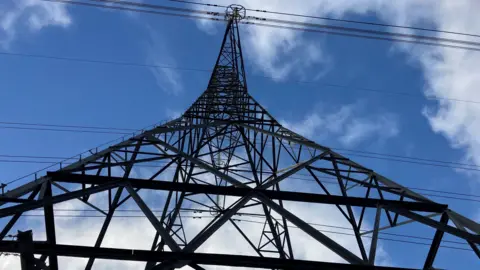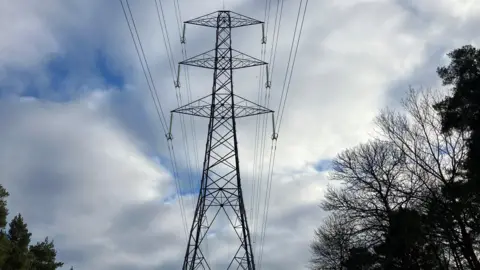Why more pylons could be heading your way
 BBC
BBCA clean energy superpower by 2030.
That's the government's ambitious target for the UK, the home of the first industrial revolution in the late eighteenth and nineteenth centuries.
Labour wants the electricity generation system to be 95% carbon-free within five years.
The energy sector says that means we're going to have to embark on another great industrial revolution but, this time round, we'll need to get there at warp speed.
Let's hope Star Trek's Scotty is up to the job.

Creating enough renewable electricity is one thing, getting that power to where it is needed is quite another.
The National Energy System Operator (NESO) estimates the UK could need up 1,000km (620 miles) of new power cables to reach the 2030 target, which the government is focused on achieving.
Wildlife campaigners fear what this will mean for places like Wildmoor Health nature reserve near Crowthorne, Berkshire.
While Matthew Stanton from the Berks, Bucks and Oxon Wildlife Trust is generally on board with the government's rush to net zero, he says ecologists like him should be given more say over where pylons go.
"Arguably, we shouldn't be having any pylons here, but there are," he says.
It is imperative, he says, that government bodies are in place to ensure that when new pylons are put in, "there's proper oversight in place".
That's the role of the country's National Energy System Operator (NESO), which says it's already doing so.
Demand for clean electricity is soaring, something that has been put into even sharper focus with the prime minister saying massive investment in artificial intelligence is key to growing our struggling economy.
Experts like the University of Reading's Jacopo Torriti say this will mean building more power-hungry computing and data centres in places, like Oxfordshire's Harwell energy centre and towns like Slough and Reading, where the computer is king.
"Data centres alone may require up to 5% more energy than we currently do as a country," he says.
"Then imagine having 30 million more or so electric vehicles on the road. That will obviously push consumption up."

The National Grid says the UK will need to build five times as much electricity transmission infrastructure over the next five years as it did in the previous 30, to handle all the extra electricity the government wants.
What about underground power cables?
The energy sector says putting cables underground can be anything from five to 15 times more expensive than running them through a pylon.
Adam Berman, from Energy UK, says that is something billpayers would never accept.
"We try and do things, as an industry, as cheaply as possible to ensure we can bring down people's bills," he says. "Ultimately, the more expensive this infrastructure is to build, the more expensive everyone's energy bills are going to be."
Wildlife experts like Mr Stanton say while they understand the economics involved, wildlife needs to be taken into account.
"Labour is looking at speeding up the planning process," he says, adding: "They obviously want a lot more electricity generation, which is good, but it's not just about speed.
"It's about making sure the right decisions are made with wildlife at the heart as well."
In recent years, campaigners worried about our green and pleasant land have focused their efforts on stopping windfarms from being built.
Soon they will have another battle on their hands, trying to block thousands more electricity pylons from springing up.
After all, while some would argue wind turbines can be a thing of beauty, nobody is ever likely to say the same about a 130ft tall steel pylon looming over the horizon.
Correction 15 April 2025: This article originally said the UK could need up to 370,000 miles of cables and pylons to reach its 2030 target. This has now been corrected to 1,000 km (620 miles).
You can follow BBC Oxfordshire on Facebook, X (Twitter), or Instagram.
